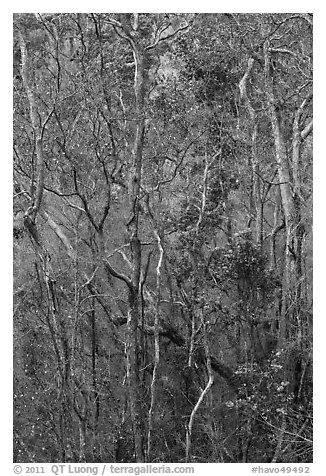The forests is home to many different types of birds like the Hawaiian owl and the palila. The palila, a honeycreeper, that only live in mamane trees are endangered because mamane trees only occur in these dry forests. The 'alala are held in captivity and won't be released until scientists believe that the forest can sustain these birds.
The link below shows a full list of the threatened and endangered species in the Hawaiian islands recorded by the U.S. Fish & Wildlife Service.
> http://www.fws.gov/pacificislands/teslist.html
 |
| The Palila - The Hawaiian Honeycreeper http://kids.britannica.com/comptons/art-144727/The-palila-is-a-species-of-Hawaiian-honeycreeper |
LOCATIONS
There are many fragments of dry forest left all over the islands of Hawaii. In Hilo, there are preserves at Volcano National Park and Mauna Kea. In Kauai, there are many fragments at Kokee State Park, near Waimea Canyon, and off the Na Pali Coast. On
Kauai there is a diverse network of plants found nowhere else on earth, not even
on the other Hawaiian islands. It's a
habitat for birds and insects that co-evolved with plants only on Kauai. It's like this also on a lot of the other
islands. In Maui, there are many fragments at Pu'u o Kali, Auwahi, and Kanaio. Kanaio actually has the most diverse fragment on the island. On Lanai, there's a preservation near Lana'ihale Kanepu'u. There are even fragments on the mountains of Oahu and Molokai. A lot of these preserves are on private and public land.
HISTORICAL STATE
Scientist
believed that Hawaii's ecosystem changed with the arrival of people, mainly the Polynesians and then the Europeans who arrived later. It was a little difficult to find out how Hawaii's tropical dry forest used to look like but the only scientific way to find out what
these dry forests used to look like is to take sediment cores in the
lakes and analyze the pollen found in the sediment. These sediment cores tell us that about 1200 years ago there used to be a lot of wiliwili, pritchardia,
and hibiscus plants growing all over Maui.
HUMAN IMPACTS
Hawaiian dry forests have suffered ever since the arrival of the Polynesians who used to burn the land for agriculture and grazing. Even now there are still fires that burn these forests and people are still trying to clear land for expansion and development. There are sometimes litter build up and, although sometimes unintentional, people pick plants and spread seeds that are not meant for certain areas.
NON-HUMAN IMPACTS
Besides human impacts on the dry forests, there are also other factors that affect this type of ecosystem. There are many invasive nonnative plants that overtake and kill endemic plant species. Examples of this are the Himalayan gingers, blackberry bushes, and Australian tree ferns that can be found in abundance near Volcano Village in Hilo. There are also predators that kill the endemic plants like wild pigs, rats, deers and even goats. The Oleander moth is a nonnative moth that likes to eat native plants which have no defenses against this moth.
 |
| The oleander moth http://www.whatsthatbug.com/2010/01/19/spotted-oleander-caterpillar-moth-5/ |
THE FUTURE
We are hoping to be able to successfully preserve these forests and allow them to grow once again. However at the rate we are going, if we continue to develop in these areas or clear the land for agriculture, then in time, we will lose these dry forests and the animals and plants that are linked to these areas.
CONSERVATION STATUS AND MAINTENANCE
The overall status of the forest is very critical. However it also depends on how you look at it. It's still very bad but compared to how it was before, it's a lot better now especially since a lot of them are becoming better protected. There are agencies and programs now that dedicate money and resources to protecting these forests like the Nature Conservancy of Hawaii and the Hawaii Natural Heritage Program. I believe that we just need to continue maintaining and protecting these areas. Fences have been built to protect these areas but can be expensive to maintain so some have even been abandoned. A strong restoration project is needed. One where people can control and regulate what happens. There's a project in the Kaupulehu Dry Forest Preserve where people are testing out restoration ideas. Basically
the forest was fenced in and anything nonnative was taken out. It's very labor intensive but as time goes on
it becomes a little less intensive. They
planted only native species and manipulated conditions, but they found that
complete removal of nonnative species can also have a negative effect. Conservationists are learning from this in
order to successfully restore these areas.
Not only that but we need to continue to advocate on behalf of the forest. People need to know that they should be careful not to do anything that can affect these forests.
These dry forests are important to the Hawaiian culture and their traditions. Not only that but they are also aesthetically
pleasing to look at.
Reference
Pau, Stephanie, Thomas Gillespie, and Jonathan Price. "Natural History, Biogeography, and Endangerment of Hawaiian Dry Forest Trees." SpringerLink. Springer Science Business Media, 2009. Web. 22 Nov. 2012.
"Hawaii Tropical Dry Forests." Hawaii Tropical Dry Forests. N.p., 31 Aug. 2007. Web. 22 Nov. 2012.
Cordell, Susan; McClellan, Moana; Yarber Carter, Yvonne; Hadway, Lisa J. 2008. Towards restoration of Hawaiian tropical dry forests: the Kaupulehu outplanting programme. Pacific Conservation Biology 14: 279-284.
"What Is a Dryland Forest?" Nahelehele Dryland Forest Restoration |. N.p., n.d. Web. 24 Nov. 2012. http://www.drylandforest.org/what-dryland-forest-1.
The World's Most Endangered Forests. Dir. UCtelevision. YouTube. YouTube, 16 Sept. 2010. Web. 24 Nov. 2012.
http://www.youtube.com/watch?v=_49R_J8Zpaw.
US. Fish & Wildlife Service. Threatened and Endangered Species - Pacific Islands Fish and Wildlife Office. N.p., n.d. Web. 23 Nov. 2012.
http://www.fws.gov/pacificislands/teslist.html.
US. Fish & Wildlife Service. Threatened and Endangered Species - Pacific Islands Fish and Wildlife Office. N.p., n.d. Web. 23 Nov. 2012.
http://www.fws.gov/pacificislands/teslist.html.



Awesome!
ReplyDelete